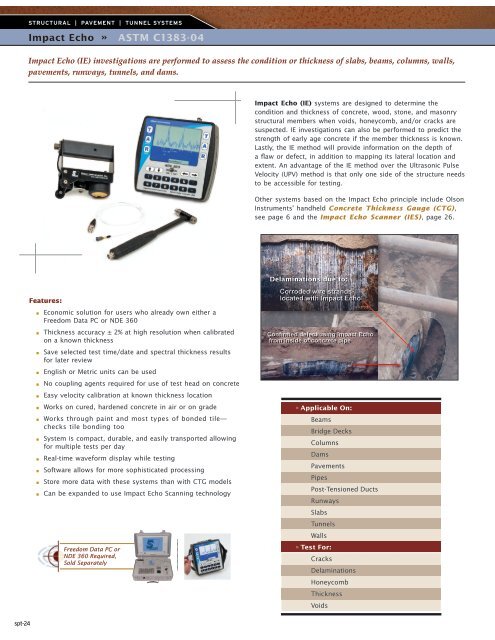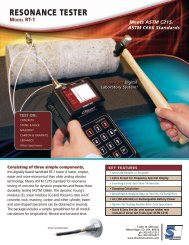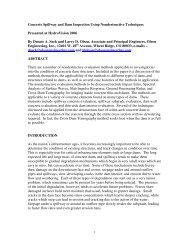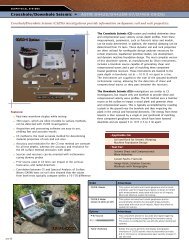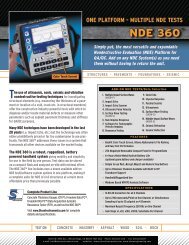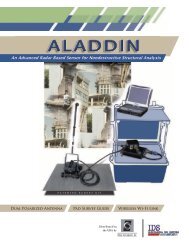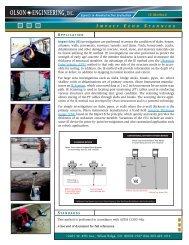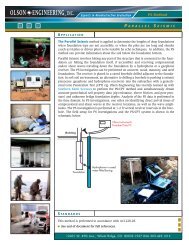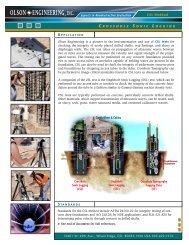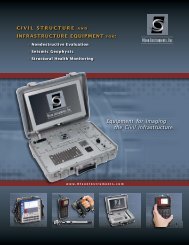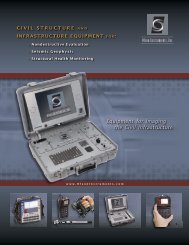Impact Echo - Olson Instruments, Inc.
Impact Echo - Olson Instruments, Inc.
Impact Echo - Olson Instruments, Inc.
You also want an ePaper? Increase the reach of your titles
YUMPU automatically turns print PDFs into web optimized ePapers that Google loves.
spt-24<br />
structural | PaVEMENt | tuNNEl systEMs<br />
Crosshole <strong>Impact</strong> NDE 360 <strong>Echo</strong> Sonic » » One ASTM Logging Platform C1383-04 » - Multiple ASTM D6760-02 NDE Tests | ACI 228.2R<br />
<strong>Impact</strong> <strong>Echo</strong> (IE) investigations are performed to assess the condition or thickness of slabs, beams, columns, walls,<br />
pavements, runways, tunnels, and dams.<br />
Features:<br />
■■ Economic solution for users who already own either a<br />
Freedom Data PC or NDE 360<br />
■■ Thickness accuracy ± 2% at high resolution when calibrated<br />
on a known thickness<br />
■■ Save selected test time/date and spectral thickness results<br />
for later review<br />
■■ English or Metric units can be used<br />
■■ No coupling agents required for use of test head on concrete<br />
■■ Easy velocity calibration at known thickness location<br />
■■ Works on cured, hardened concrete in air or on grade<br />
■■ Works through paint and most types of bonded tile—<br />
checks tile bonding too<br />
■■ System is compact, durable, and easily transported allowing<br />
for multiple tests per day<br />
■■ Real-time waveform display while testing<br />
■■ Software allows for more sophisticated processing<br />
■■ Store more data with these systems than with CTG models<br />
■■ Can be expanded to use <strong>Impact</strong> <strong>Echo</strong> Scanning technology<br />
Freedom Data PC or<br />
NDE 360 Required,<br />
Sold Separately<br />
<strong>Impact</strong> <strong>Echo</strong> (IE) systems are designed to determine the<br />
condition and thickness of concrete, wood, stone, and masonry<br />
structural members when voids, honeycomb, and/or cracks are<br />
suspected. IE investigations can also be performed to predict the<br />
strength of early age concrete if the member thickness is known.<br />
Lastly, the IE method will provide information on the depth of<br />
a flaw or defect, in addition to mapping its lateral location and<br />
extent. An advantage of the IE method over the Ultrasonic Pulse<br />
Velocity (UPV) method is that only one side of the structure needs<br />
to be accessible for testing.<br />
Other systems based on the <strong>Impact</strong> <strong>Echo</strong> principle include <strong>Olson</strong><br />
<strong>Instruments</strong>’ handheld Concrete Thickness Gauge (CTG),<br />
see page 6 and the <strong>Impact</strong> <strong>Echo</strong> Scanner (IES), page 26.<br />
Delaminations due to:<br />
Corroded wire strands<br />
located with <strong>Impact</strong> <strong>Echo</strong><br />
Confirmed defect using <strong>Impact</strong> <strong>Echo</strong><br />
from inside of concrete pipe<br />
» Applicable On:<br />
Beams<br />
Bridge Decks<br />
Columns<br />
Dams<br />
Pavements<br />
Pipes<br />
Post-Tensioned Ducts<br />
Runways<br />
Slabs<br />
Tunnels<br />
Walls<br />
» Test For:<br />
Cracks<br />
Delaminations<br />
Honeycomb<br />
Thickness<br />
Voids
<strong>Impact</strong> Crosshole <strong>Echo</strong> Sonic » ASTM Logging C1383-04 » ASTM D6760-02 | ACI 228.2R<br />
Method<br />
In conventional IE investigations, the hammer or<br />
impactor is used to generate compressional waves that<br />
reflect back from the bottom of the tested member or<br />
from a discontinuity. The response of the system is then<br />
measured by the receiver placed next to the impact<br />
point. Only one relatively smooth and clean surface<br />
needs to be accessible for receiver placement and<br />
hammer or solenoid impact.<br />
Data Collection<br />
The user friendly IE software is written and tested at<br />
<strong>Olson</strong> <strong>Instruments</strong>’ corporate office in Colorado. We do<br />
not outsource any tech support questions and, should<br />
you require software support, we welcome your<br />
questions and comments.<br />
Available Models<br />
The <strong>Impact</strong> <strong>Echo</strong> system is available in eight different<br />
models which can be run from <strong>Olson</strong>’s Freedom Data PC<br />
or NDE 360 Platforms:<br />
1. <strong>Impact</strong> <strong>Echo</strong>-1 (IE-1)<br />
2. <strong>Impact</strong> <strong>Echo</strong>-1 + Super Thin (IE-1-ST)<br />
3. <strong>Impact</strong> <strong>Echo</strong>-1 + Surface Wave (IE-1-SW)<br />
4. <strong>Impact</strong> <strong>Echo</strong>-1 + Super Thin + Surface Wave<br />
(IE-1-ST-SW)<br />
5. <strong>Impact</strong> <strong>Echo</strong>-2 (IE-2)<br />
6. <strong>Impact</strong> <strong>Echo</strong>-2 + Super Thin (IE-2-ST)<br />
7. <strong>Impact</strong> <strong>Echo</strong>-2 + Surface Wave (IE-2-SW)<br />
8. <strong>Impact</strong> <strong>Echo</strong>-2 + Super Thin + Surface Wave<br />
(IE-2-ST-SW)<br />
Data Example » 1<br />
Model advantages<br />
structural | PaVEMENt | tuNNEl systEMs<br />
Receiver<br />
<strong>Impact</strong> <strong>Echo</strong><br />
Test Head<br />
IE - Concrete Location<br />
Source<br />
Void<br />
Reflection from slab/void interface<br />
IE-1 Model Will store more data than CTG systems. Tests concrete between<br />
3.2" to 6 ft (81 mm to 1.8 m). <strong>Inc</strong>ludes impactor solenoid and<br />
displacement transducer<br />
IE-1-ST Model Allows user to test concrete down to 1.5" (38 mm)<br />
IE-1-SW Model Allows user to perform Surface Wave (SW) tests with 8" arm (203 mm)<br />
(see CTG-SW section, page 7 for more details)<br />
IE-1-ST-SW Model Allows user to test concrete down to 1.5" (38 mm) and perform<br />
Surface Wave (SW) tests<br />
IE-2 Model In addition to impactor solenoid and displacement transducer,<br />
includes accelerometer and small impulse hammer<br />
IE-2-ST Model Allows user to test concrete down to 1.5" (38 mm)<br />
IE-2-SW Model Allows user to perform Surface Wave (SW) tests<br />
Performing the IE<br />
method at a sound<br />
concrete location gives<br />
results similar to the<br />
figure shown. A single,<br />
sharp, clear peak<br />
representing a known<br />
thickness is indicative<br />
of sound concrete. The<br />
slab investigated was<br />
10 inches thick and the<br />
bottom echo results in<br />
a peak at 10 inches.<br />
IE-2-ST-SW Model Allows user to test concrete down to 1.5" (38 mm) and perform<br />
Surface Wave (SW) tests<br />
spt-25


